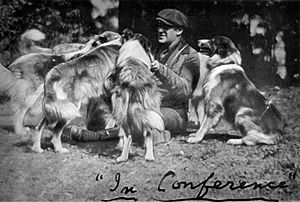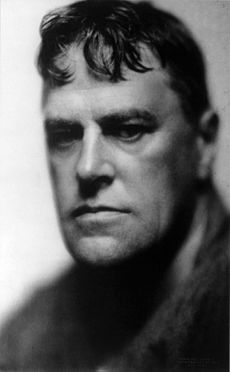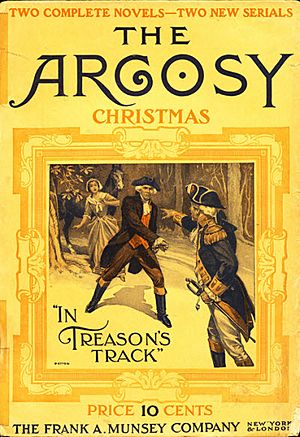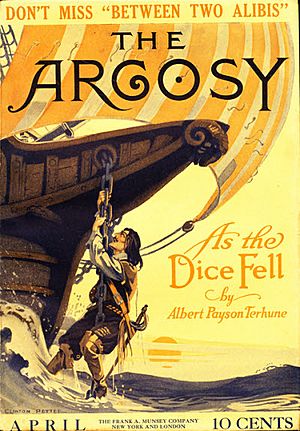Albert Payson Terhune facts for kids
Quick facts for kids
Albert Payson Terhune
|
|
|---|---|
 |
|
| Born | December 21, 1872 |
| Died | February 18, 1942 (aged 69) |
| Resting place | Pompton Reformed Church |
| Education | Columbia University |
| Occupation | Writer |
| Known for | Author Sunnybank Kennels |
| Spouse(s) | Lorraine Bryson Anice Terhune |
| Children | Lorraine Virginia Terhune Stevens (1898–1956) |
| Parent(s) | Edward Payson Terhune Mary Virginia Hawes |
| Relatives | Christine Terhune Herrick (1859–1944), sister Virginia Terhune Van De Water (1865–1945), sister |
| Signature | |
Albert Payson Terhune (born December 21, 1872 – died February 18, 1942) was an American writer, dog breeder, and journalist. He became very famous for his books about the adventures of his beloved collies. He was also known for breeding collies at his home, Sunnybank Kennels. The dog lines from his kennels are still part of today's Rough Collie dogs.
Contents
About Albert Payson Terhune
Albert Payson Terhune was born in New Jersey. His mother, Mary Virginia Hawes, was a writer who used the name Marion Harland. His father was Reverend Edward Payson Terhune. Albert had four sisters and one brother. Only two of his sisters, Christine and Virginia, lived to be adults.
Sunnybank was first the family's summer home. Terhune made it his full-time home in 1912. He went to Columbia University and earned a degree in 1893. From 1894 to 1916, he worked as a reporter for a newspaper called The Evening World.
Albert Terhune was also interested in boxing. He took part in special boxing matches with famous boxers like James J. Corbett.
His Sunnybank Kennels became "the most famous collie kennels in the U.S." This is where he raised and bred rough collies.
"Bert" Terhune was an active member of the Adventurers' Club of New York. This was a club for people who enjoyed exploring and adventure.
Terhune was married two times. His first wife, Lorraine Bryson Terhune, passed away when she was 23. This happened shortly after their daughter, Lorraine Virginia, was born. He later married Anice Terhune. They did not have any children together. Albert Payson Terhune died on February 18, 1942. He was buried at the Pompton Reformed Church in Pompton Lakes, New Jersey.
Terhune's Lasting Impact
Albert Payson Terhune's home, Sunnybank, is in Wayne, New Jersey. Today, it is a public park called Terhune Memorial Park – Sunnybank. Visitors can see the graves of many of the dogs from Terhune's books. You can also find a collection of his books and dog awards at the Van Riper-Hopper Historic House Museum.
Other items from the Terhune family home are at the Pompton Lakes Historical Museum. The Albert Payson Terhune Elementary School in Wayne, New Jersey, is named after him. Their school mascot is a collie dog. In Pequannock Township, New Jersey, nearby, there are streets named Payson Road, Terhune Ave, and Ladd Street. These names honor him and one of his famous dog characters.
In a story by Harlan Ellison called A Boy and His Dog, the dog calls his owner "Albert." This was a special nod to Terhune.
Terhune's Writing Career
Albert Payson Terhune first wrote short stories about his collie dog, Lad. These "Lad Stories" appeared in popular magazines like Red Book and The Saturday Evening Post.
His first novel about his dogs was Lad, A Dog. This book brought together many stories about his collie, Lad. After Lad, he wrote over 30 more novels focusing on dogs. Two more books were also about Lad.
Lad: A Dog was published in 1919. It became a best-seller for both adults and young readers. The book has been printed more than 80 times. In 1962, it was even made into a movie.
List of Works
- Syria from the Saddle (1896)
- Columbia Stories (1897)
- How to Box to Win (1900) (written as "Terry McGovern")
- Dr. Dale: A Story Without a Moral (1900) (with Marion Harland)
- The New Mayor (1907)
- Caleb Conover, Railroader (1907)
- The World's Great Events (1908)
- The Fighter (1909)
- The Return of Peter Grimm (1912, novelization of the play by David Belasco)
- The Woman (1912)
- Famous American Indians (1912)
- Around the World in Thirty Days (1914)
- Dad (1914) (with Sinclair Lewis)
- The Story of Damon and Pythias (1915)
- The Red Circle novelization (1915)
- Superwomen (1916) republished as Famous Hussies of History (1943)
- Dollars and Cents (1917)
- The Years of the Locust (1917)
- Fortune (1918)
- Wonder Women In History (1918)
- Lad: A Dog (1919)
- Bruce (1920)
- Buff: A Collie (1921)
- The Man in the Dark (1921)
- His Dog (1922)
- Black Gold (1922)
- Black Caesar's Clan (1922)
- Further Adventures of Lad (1922) republished as Dog Stories Every Child Should Know (1941)
- The Pest (1923)
- Lochinvar Luck (1923)
- The Amateur Inn (1923)
- Grudge Mountain (1923) republished as Dog of the High Sierras (Grosset & Dunlap)
- Treve (1924)
- The Tiger's Claw (1924)
- The Heart of a Dog (1924)
- Now That I'm Fifty (1924)
- The Runaway Bag (1925)
- Wolf (1925)
- Najib (1925)
- Treasure (1926) republished as The Faith of a Collie (1949)
- My Friend the Dog (1926)
- Gray Dawn (1927)
- The Luck of the Laird (1927) republished as A Highland Collie (1950)
- Bumps (1927)
- Blundell's Last Guest (1927)
- Water! (1928)
- Black Wings (1928)
- Loot (1928) republished as Collie to the Rescue (1940)
- The Secret of Sea-Dream House (1929)
- Lad of Sunnybank (1929)
- To the Best of My Memory (1930)
- Diana Thorne's Dog Basket: A Series of Etchings (1930)
- Proving Nothing (1930)
- A Dog Named Chips (1931)
- The Son of God (1932)
- The Dog Book (1932)
- The Way of a Dog (1932)
- Letters of Marque (1934)
- The Book of Sunnybank (1934) republished as Sunnybank: Home of Lad (1953)
- Real Tales of Real Dogs (1935)
- True Dog Stories (1936)
- The Critter and Other Dogs (1936)
- Unseen! (1937)
- The Terhune Omnibus (1937) republished as The Best-Loved Dog Stories of Albert Payson Terhune (1954)
- A Book of Famous Dogs (1937) republished as Famous Dog Stories Every Child Should Know (1937)
- Grudge Mountain (1939) republished as Dog of the High Sierras (1951)
- Dogs (1940)
- Loot! (1940) republished as Collie to the Rescue (1952)
- Across the Line (1945) (with notes and commentary by Anice Terhune)
- Wallace: Glasgow's Immortal Fire Dog (1961)
- Great Dog Stories (1994) five stories from The Heart of a Dog and five stories from My Friend the Dog
In Popular Culture
- Albert Payson Terhune was mentioned in Charles M. Schulz's comic strips, Lil' Folks and "Peanuts".
- He is also mentioned in Roger Zelazny's book This Immortal.
- In the movie A Boy and His Dog, a telepathic dog calls his human friend "Albert." This is a hidden reference to Terhune.
- The main character in Edward Bunker's novel "Little Boy Blue" enjoys reading books about Collie dogs by Albert Payson Terhune.





